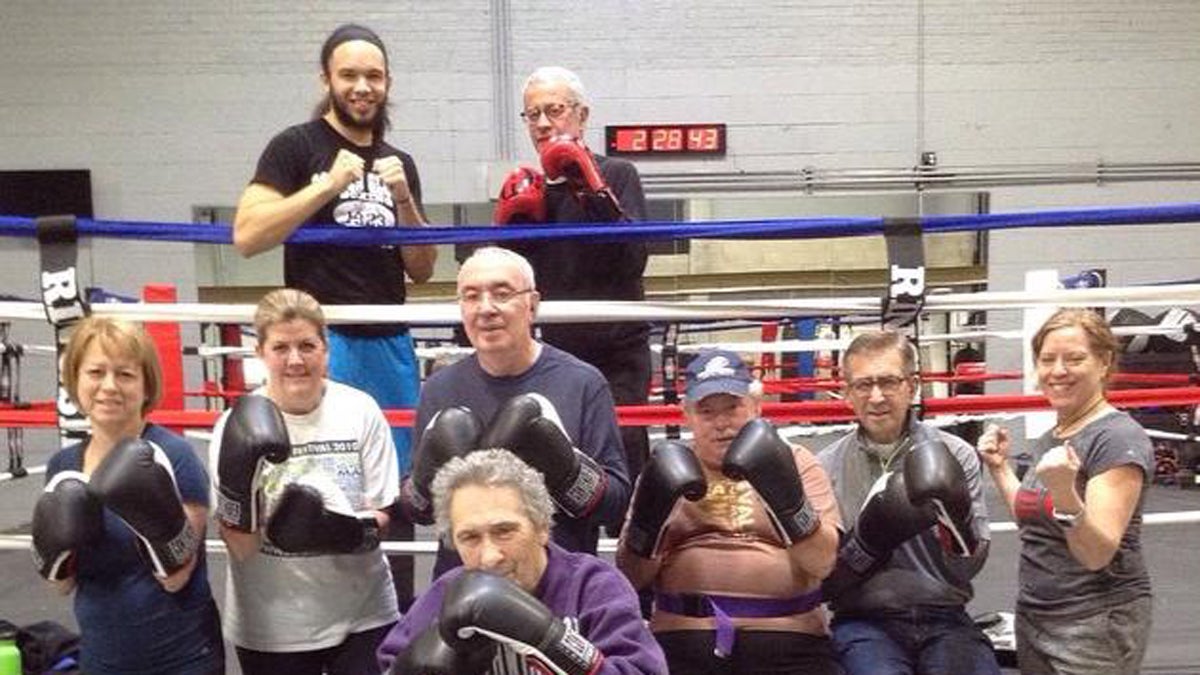‘Rock Steady’ boxing workout is helping some in fight against Parkinson’s disease
Listen
Falcon Boxing Gym is located in a northern suburb of Chicago and is one of several U.S. locations offering the Rock Steady Method for people with Parkinson's disease (Photo courtesy of Sam Rodriguez)
What started in a small gym in Indianapolis is now popping up in gyms and physical therapy centers across the country.
It’s called the Rock Steady Method and it’s a non-contact type of boxing workout.
During a recent Thursday afternoon class, coach Sam Rodriguez calls out a workout to about 10 Parkinson’s patients.
“Today we are going into heavy back competition,” he shouts.
This workout is for a group of people who might surprise you. All of these folks have Parkinson’s Disease, also called PD by many living with the disease and people in the medical community. They are all participating in a non-contact boxing workout, as a way to cope with the progressive disease. This is the same sport linked to cognitive delays and possibly even PD.
“We are going to have four people on each side of the bag. Get some distance between you and that bag,” yells Rodriquez. “You don’t want to look like a Rock Em’ Sock Em.”
Dr. Elizabeth Zauber, assistant professor of Neurology at Indiana School of Medicine and a movement disorder specialist says research shows good things happen in the brain when PD patients exercise.
“Animals that exercise release neurotropic factors so those are chemicals in the brain that help protect brain cells. The brains become more sensitive to dopamine, which is the main chemical that is reduced in Parkinson’s,” says Zauber.
People with Parkinson’s have a loss of nerve endings and neurons that produce the important brain chemical, dopamine. The reduction of this chemical is mostly to blame for a PD person’s inability to move. It’s common knowledge that exercise has lots of benefits but what’s so special about a boxing workout?
Stephanie Combs-Miller, clinical researcher at University of Indianapolis Krannet School of Physical Therapy did a two-year study on the effectiveness of the Rock Steady program. She and researchers followed two groups of Parkinson’s patients, one group worked the Rock Steady program, the other group did more traditional exercises like aerobic classes, or walking.
She says there were several surprises during the study. “The intensity of the program and that the expectation that they work out intensely from the coaches but also that they were doing it,” she said, “It was amazing to me, my jaw hit the floor the first time I saw it.”
She also found the boxers showed better balance, walking function and could even reach further.
Coach Rodriguez has also seen the benefits of this workout. “A lot of research goes into medication or cures on trying to help PD patients,” he says. “But not much goes into the right now. How can we better the quality of life of the PD patients right now? And if I can be apart of that and help them right now, then I am on it.”
Falcon Boxing Gym is located in a northern suburb of Chicago and is one of several U.S. locations offering the Rock Steady Method. The class starts with a walking or jogging warm up. Then they rotate through a strength training circuit, spending a minute or two at each station. After that, the gloves go on and boxers start throwing punches at the bags or hand pads.
Tom Moore, 66, is a retired public defender and father to four adult daughters. He was diagnosed with Parkinson’s about a year ago and has never been to a boxing gym before coming to Falcon.
He explains, “At one point, not too long ago, I couldn’t stand up by myself and it was scary. I would fall at home, have no one there and be forced to call a paramedic. I am just hopeful that I will be able to survive and preserve myself long enough to benefit from some breakthrough that is coming in the future.”
Moore can now stand without help and walks more confidently without his cane or walker. His story is similar to many Rock Steady boxers. They get stronger, find camaraderie in their fight against Parkinson’s and begin to show some health improvements.
“One of the things I was pleased to find was that the boxers reported a higher perception of quality of life,” says Dr. Combs. “It’s pretty impressive, that over that span, there was a significant difference in those two groups in the way they perceive their quality of life when there was no difference in the severity of the disease.”
At the gym, the class is getting ready for heavy bag work. Everyone puts on gloves and lines up behind the heavy bag as Sam calls out the workout. In pairs of two, they hit the heavy bag as hard as they can. After everyone has had a couple of turns, Coach Rodriquez gathers his class in a tight circle. The boxers put in their hands for one, last, unified chant, “1, 2, 3 Rock Steady!”
WHYY is your source for fact-based, in-depth journalism and information. As a nonprofit organization, we rely on financial support from readers like you. Please give today.



